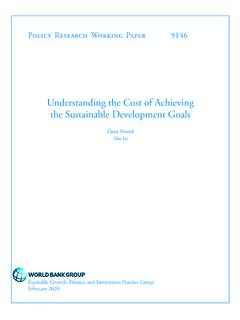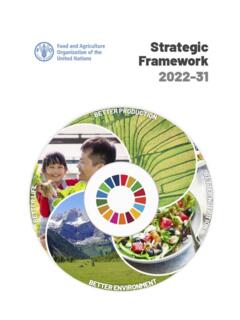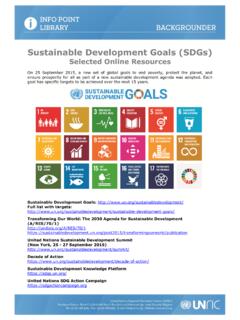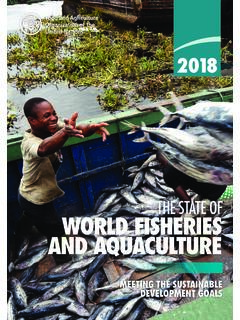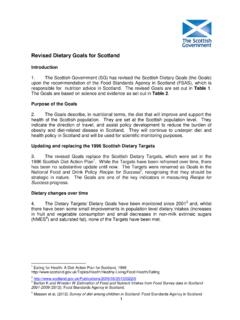Transcription of Sustainability in the food industry: progress and
1 Sustainability in the food industry: progress and next steps Content1 Introduction ..32 Defining Sustainability .. 63 Food industry actions on Sustainability .. 84 Drivers of Sustainability .. 175 Is the food industry doing enough? .. 19 6 Next steps towards a sustainable food industry .. 20 7 Conclusion .. 24 Methods and acknowledgements .. 24 in the food industry: progress and next steps 1 Introduction The food and drink industry is facing an unprecedented set of challenges. The global population is expected to increase to 9 million by 2050, resulting in a 60% increase in demand for food -- yet natural resources such as land, water and biodiversity are already under pressure. Rising temperatures and extreme weather events, the consequences of climate change, have already shown an ability to cause severe disruption to global food supplies, as has political instability.
2 Massive inequalities exist on a global scale between people who have access to sufficient, healthy and nutritious food and those who do not1. But the food sector is, itself, a major contributor to these challenges. For instance, industrial livestock farming is responsible for of total global greenhouse gas (GHG) emissions2, and agriculture is responsible for 75% of global deforestation3. (Source: Gerber PJ, Steinfeld H, Henderson B, Mottet A, Opio C, Dijkman J, Falcucci A & Tempio G. 2013. Tackling climate change through livestock A global assessment of emissions and mitigation opportunities. Rome, Italy: Food and Agriculture Organization of the United Nations (FAO).31 Gerber PJ et al 2013. Tackling climate change through livestock A global assessment of emissions and mitigation opportunities.)
3 Rome, Italy: Food and Agriculture Organization of the United Nations (FAO).3 ); )1 Source: [US-EPA] United States Environmental Protection Agency. 2011. Global anthropogenic non-CO2 greenhouse gas emissions: 1990 2030 EPA 430-D-11-003. (Draft.) Office of Atmospheric Programs, Climate Change Division. Washington, DC: Environmental Protection Agency. (Available from ) Vermeulen SJ, Campbell BM, Ingram J SI. 2012. Climate change and food systems. Annual Review of Environmental Resources 37. (Available from )4 The last five years have seen an increase in efforts to improve the Sustainability of the European food and drink sector, as the threats to its future viability have become ever more apparent and in the context of international commitments such as the Sustainable Development Goals in 2015 and the Paris Climate aim of this paper is to highlight Sustainability initiatives and good practices introduced by food companies to date, to identify barriers to more radical and accelerated action, and to outline the next steps for industry and other stakeholders in the food system.
4 Source: [FAO] Food and Agriculture Organization of the United Nations. 2013b. Food wastage footprint. Impacts on natural resources. Summary Report. Rome, Italy: FAO (Available from )5 The need to ensure consistent supply of raw materials promotes mono-cropping over mixed farming methods, contributing to soil degradation and reducing biodiversity. Global sourcing practices, too, are all too often extractive, paying little heed to the disastrous environmental, social and economic impacts for small scale farmers and their communities. Meanwhile, one third of all the food that is produced is wasted along the supply chain4. 4 Brundtland Report, Our Common Future, established three pillars of Sustainability -- economic, environmental, and social -- which should be addressed simultaneously and in a global context.
5 While this definition and conceptualisation remain broadly relevant today, over the last 30 years unequal emphasis has been placed on economic Sustainability , even as greater understanding has emerged of the environmental challenges faced by the world. The social aspect of Sustainability has, however, gained importance and relevance since the publication of the UN Guidelines on Business and Human Rights in the general public, relatively few have a rounded appreciation of all three pillars of Sustainability . Rather, there is a tendency to focus on individual environmental impacts of food and other consumer goods or on social and ethical issues. This disjoined understanding may be due to labelling that emphasises single sustainable attributes of products, often through logos of certification schemes -- a practice that is both easier for marketers and breaks down the complex issues to easy-to-understand Defining Sustainability The most commonly-cited definition of sustainable development was set out in 1987 by the Brundtland Commission, a high-level body convened by the United Nations to foster international cooperation for a more sustainable future:65 Sustainable development is development that meets the needs of the present without compromising the ability of future generations to meet their own needs.
6 52 The lack of consensus over a detailed definition of Sustainability has also meant many different ways of assessing Sustainability have been devised. In the UK alone there are over 100 different tools for assessing farm Sustainability , with farmers often undergoing multiple, over-lapping, time-consuming, and expensive assessments each Sustainable Development Goals ( sdgs )8, adopted by the United Nations in 2015, build on the Millennium Development Goals and provide a useful framework for understanding and acting upon the issues over a 15 year period. While only around a third of the general population were familiar with the sdgs in 2015, according to a survey conducted by PwC, awareness amongst the business community was at 92%9. The latter figure is crucial as the sdgs serve as a useful framework for food businesses to map aspirations and activities.
7 While they are intended to be seen as integrated and non-divisible, the indicators for goals 2, 5, 6, 12, 14 and 15 are monitored by the Food and Agriculture Organization of the United Nations (FAO) and are key for food and drink businesses. Goal 3 is also very pertinent to the sector, while goals 8, 9, 13 and 17 are relevant for companies across all Survey conducted in June-July 2015 and generated 986 responses from businesses and 2105 from citizens. Food industry actions on sustainabilityDespite relatively low awareness of the sdgs among the general population, many consumers are increasingly interested in sustainable and ethically sourced food and drink products -- and manufacturers are catering to the demand. Data from Mintel s Global New Products Database indicated a marked increase in new products carrying almost all kinds of sustainable and ethical claims on their labels between 2013 and 2017.
8 Source: Mintel s Global New Products DatabaseIn 2017 Europe saw the highest number of new products making general sustainable, organic, RSPO (Roundtable on Sustainable Palm Oil), and fair trade claims, while the Middle East and Africa came out tops on ethically sourced : Mintel s Global New Products Database83 Sustainability is also a factor in some of the key trends that are influencing product development -- and, as a result, the ingredients sector. For instance, there is widespread belief that organically-grown product is better for the environment11, and awareness of the disproportionately high CO2 emissions from the livestock sector is driving interest in alternative protein sources, such as pulses and insects, and the trend towards meat-free diets12.
9 In terms of business practices, the latest report from Oxfam s Behind the Brands campaign shows a significant progress on environmental and sustainable issues by the Big 10 food and drink manufacturers between 2013 and 201613,14. 9 Source: Mintel s Global New Products DatabaseBehind the BrandsOxfam s Behind the Brands campaign evaluated publicly-available information on corporate policies, with a focus on seven themes. 1) Land both rights and access to land and sustainable use of it 2) Women farm workers and small-scale producers in the supply chain 3) Farmers (small-scale) growing the commodities 4) Farm workers in the supply chain 5) Climate change commitments to reduce greenhouse gas emissions and deforestation in agricultural supply chains, and to help farmers adapt to climate change 6) Transparency at a corporate level 7) Water both rights and access to water resources and sustainable use of it Scores for each theme (except transparency) were calculated using indicators grouped into four categories: awareness, knowledge, commitments, and supply chain management.
10 The transparency theme was broader in scope and rewarded companies for their disclosure on corporate issues such as taxation. 11 Emma Schofield, global food science analyst, Mintel. Powerpoint presentation on Sustainability : Ingredient Insight August 2017. 12 The Sustainable Food Trust points out that consumers adoption of meat-free diets on environmental grounds is misguided, as grass-fed ruminants play a central role in re-building soil fertility and carbon gain that off-sets the animals methane emissions. Consequently, switching to eating meat and dairy from grass-fed, rather than industrially-reared, animals is more helpful (Patrick Holden, director of the Sustainable Food Trust, during the panel discussion Is the food industry doing enough to support Sustainability ?)


